In the sixteenth, seventeenth and eighteenth centuries the Paar family grew rich running the Austrian postal services. Johann Christoph von Paar was awarded the rank of Imperial Count (Reichsgraf) in 1636, and in 1769 Wenzel Johann Joseph von Paar was granted princely status as well as the additional title of Hochgeboren. Around the same time the Palais Paar, the family’s early seventeenth century Vienna residence, was given a full makeover in the Rococo style. In 1770 Prince Wenzel was responsible for the safe conduct of the ill-fated fourteen-year-old Archduchess Maria Antonia to the French border. The Paar family’s good fortune didn’t last much longer than Marie Antoinette’s: the Holy Roman Empire was dissolved in 1806, new postal networks were established, and by the early twentieth century the Palais Paar was abandoned, its windows opaque with grime. After World War I the family removed the palace’s boiseries (but not its ceilings) to one of their four castles in Bohemia, and declared the building unfit for habitation to avoid the high taxes of Red Vienna. The Palais Paar was demolished in 1938.
All four of the castles were eventually confiscated by the Czechoslovak state, but not before the Paars sold off their Vienna furnishings. Some boiseries from lesser rooms ended up in the hands of legendary Met benefactors Charles and Jayne Wrightsman. So there’s a Paar Room at the Met, Gallery 526. The best ones, however, the ones from the palace’s Paradezimmer, with its mirrored double doors, were bought in the late thirties by Antenor Patiño, a Bolivian diplomat and heir to the tin fortune of Simón Iturri Patiño, known as the ‘Andean Rockefeller.’ Antenor Patiño first installed his Paar boiseries in his Paris residence. Then, in the fifties, he built a summer palace at Estoril on the Portuguese riviera.1 It is this last fact, I suppose, that put Patiño in the position to give his Viennese interior to Lisbon’s Museu Nacional de Arte Antiga (hereafter MNAA), which he did in 1969.
Patiño died at a hospital New York on February 2, 1982, aged 85. Half a lifetime after that, in January of the present year, I was lucky enough to spend two days in Lisbon. The National Tile Museum will have to wait for a longer visit, as will the Calouste Gulbenkian Museum, but I had time for the MNAA. Passing through its Sala Patiño, I was curious enough about what I read on the room’s information panel to dig up the rest of the details set out here.
*
Unlike the other museums I’ve written about so far, the MNAA has no encyclopedic pretensions. Instead, there are just five sets of galleries: Portuguese Painting and Sculpture, European Painting, Portuguese Decorative Arts, European Decorative Arts, and Art from the Portuguese Discoveries. Almost every object on display was made between 1450 and 1800.
Portugal’s place in the history of Western art matches its geographic setting on the periphery of Europe. Can you name a Portuguese painter from any period? Hardly a sign of ignorance if you can’t. When the country comes up in an undergrad art history class in the United States, it’s generally in the context of the sixteenth century, what the MNAA calls the Portuguese discoveries. Albrecht Dürer’s famous woodcut of a rhinoceros, for example, is based on Ulysses, an Indian rhino brought from Goa to Lisbon in 1515—or I should say, is based not on Ulysses himself, but on a sketch and a written description a Lisbon merchant sent to a friend in Nuremberg. Then there are the Nanban screens, paintings of the ‘Southern barbarians,’ mostly Portuguese, who began to visit Japan in the 1540’s.
But art made in Portugal, by Portuguese artists? That would be new to me. The European collection had one painting I was excited to see, a triptych by Hieronymus Bosch. What else? I had no idea.
*
In the Golden Legend, Jacobus de Voragine’s thirteenth century compendium of hagiographies, the life of the desert ascetic Saint Anthony (251–356) runs to just over three pages. The word demon appears several times.
[Anthony] bore countless trials inflicted by demons… a crowd of demons tore at him so savagely that his servant thought he was dead… [demons] appeared in the form of various wild beasts and tore at his flesh cruelly with their teeth, horns, and claws. …he was carried aloft by angels, but demons were there to bar his way…
There are also devils.
Once when he had overcome the spirit of fornication by the virtue of faith, the devil appeared to him in the form of a black child, prostrated himself, and admitted that he was conquered.
And finally an unspecified monster.
…a huge, terrifying being whose head towered to the clouds, and also figures with wings trying to fly upwards but being held back by the monster’s outstretched hands…
That’s pretty much it. Demons may have put Anthony through countless trials, but only a few of them are described here. Most of what I’ve quoted comes right at the beginning, before the account moves on to Anthony’s encounters with other monks and his epistolary quarrel with an Arian adversary, Ballachius. There are additional paragraphs on Anthony a few pages away, in the life of another ascetic, Saint Paul the Hermit. Anthony, venturing into the desert in search of Paul, meets a centaur, and then a wolf, but no demons. Once the two men are together, in a scene conceived in a memorable fashion by Velázquez, a crow brings them a loaf of bread.2
The original life of Anthony, written in Greek by Athanasius of Alexandria (c. 296/98–373) and translated into Latin by Evagrius of Antioch (d. 392), is quite a bit longer and more detailed. And it’s written in prose that one scholar finds comparable not to biography as we know it but to Beowulf or Raiders of the Lost Ark.3
Well, the role of an evildoer is easy for the Devil. That night, therefore, they made. such a din that the whole place seemed to be shaken by an earthquake. It was as though demons were breaking through the four walls of the little chamber and bursting through them in the forms of beasts and reptiles. All at once the place was filled with the phantoms of lions, bears, leopards, bulls, and of serpents, asps, and scorpions, and of wolves; and each moved according to the shape it had assumed. The lion roared, ready to spring upon him, the bull appeared about to gore him through, the serpent writhed without quite reaching him, the wolf was rushing straight at him; and the noises emitted simultaneously by all the apparitions were frightful and the fury shown was fierce.4
The fifteenth- and sixteenth-century artists who depicted Anthony’s torments had both the original and the abridgment at their disposal. To mention a few of these: from the 1430’s, Sassetta’s panel of devils clubbing him and pulling his hair. Several decades later, Schongauer’s famous engraving of Anthony in the air, copied, according to Vasari (and the Kimbell Museum), by the teenaged Michelangelo. The right wing of the inner panel of Matthias Grünewald’s Isenheim Altarpiece (c. 1512–16), with its depiction of a man suffering from the deadly variety of gangrene called ergotism, caused by a mold that grew on old rye. Ergotism was also known as Saint Anthony’s fire, because monks of the Order of Saint Anthony treated the disease at hospitals such as the one they ran at Isenheim. The order was founded in 1095 after the relics of Saint Anthony, preserved at a monastery in Isère in southeastern France, cured a nobleman’s son.
Sassetta, Schongauer, Michelangelo, Grünewald—and Hieronymus Bosch. Today it is the Garden of Earthly Delights that inspires films and ballets and turns up on the cover of novels and essay collections, but in Bosch’s own time he was better-known for his Anthony paintings. It is unclear how many there were, how many have been lost. The monk and historian José de Sigüenza (1544–1606) mentions several in Spanish collections, including, in his own cell at El Escorial, “a fine one in which I sometimes read and lose myself.”5 Today two single panels, in Madrid and Kansas City, are attributed to Bosch, and there are many copies and pastiches. One of the latter, held in Genoa and once attributed to Pieter Bruegel the Elder, inspired Gustave Flaubert to write a novel about Anthony.
There are the panels and the copies, and then there’s the great triptych in Lisbon, the Temptations of Saint Anthony, with two scenes of the Passion of Christ in grisaille when closed, and three panels of Anthony and his demons, torments and temptations when open.
*
Is there a best way to approach a painting by Hieronymus Bosch? Should one read, before setting foot in the museum, about Anthony, about ergotism, about Netherlandish iconography? Or is it preferable to consult nothing, to go in cold, to read in the work and lose oneself?
The answer, to be sure, is both. Go, look, take a few pictures, have coffee, go back, look more, take more pictures. Then do the reading, whether in primary sources like Sigüenza, secondary works such as Joseph Koerner’s Bosch and Bruegel: From Enemy Painting to Everyday Life, or on Wikipedia. Then go again, informed. Easy, if you live in Lisbon, or are rich in both time and money. Otherwise, if you make it at all, you have to choose one or the other.
I went in cold. I didn’t bring the Golden Legend with me to Europe, to read in my Airbnb the night before. I didn’t look into the popularity of the cult of Anthony in the fifteenth century Netherlands. I didn’t puzzle over Koerner’s unexpected comparison of Anthony’s predicament to that of Jim Carrey in The Truman Show.6 I looked and took pictures. I wish I’d taken more, but here are a few, all from the middle panel.
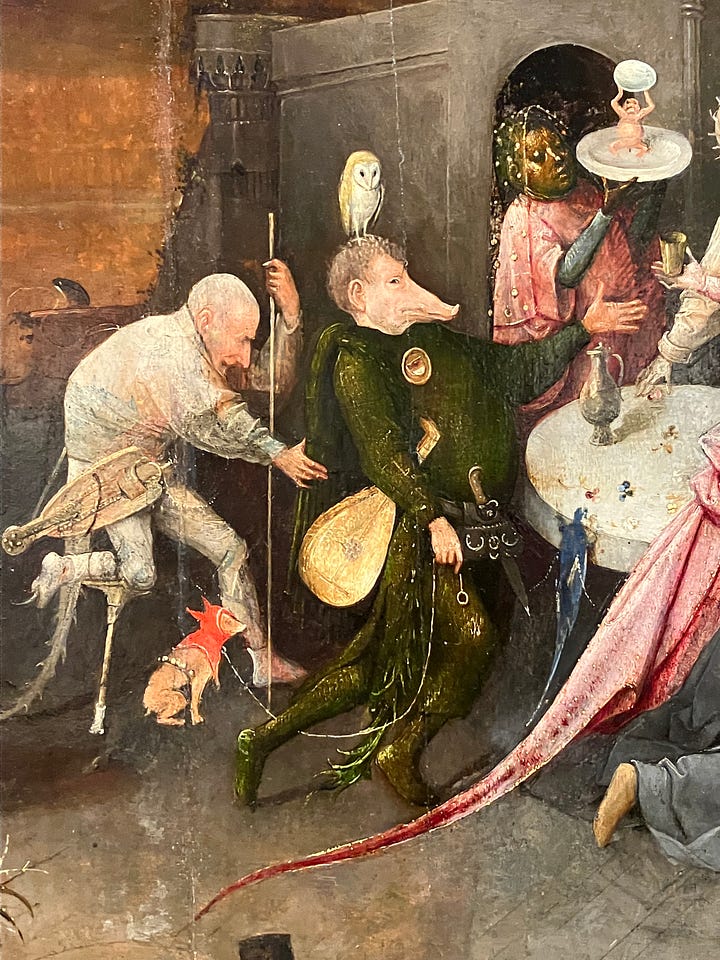
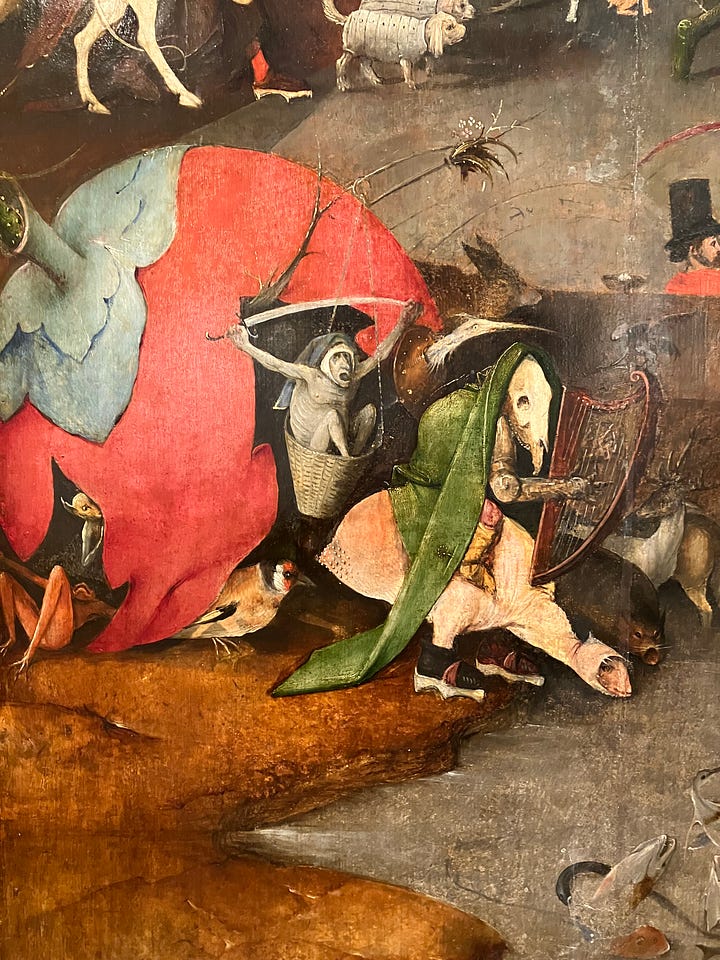
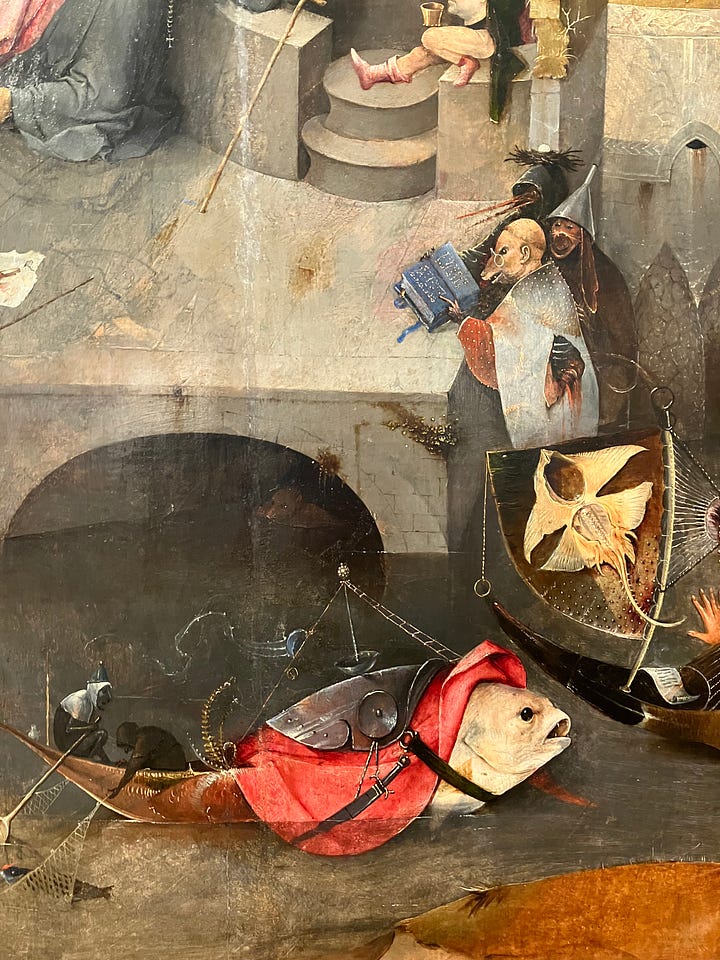
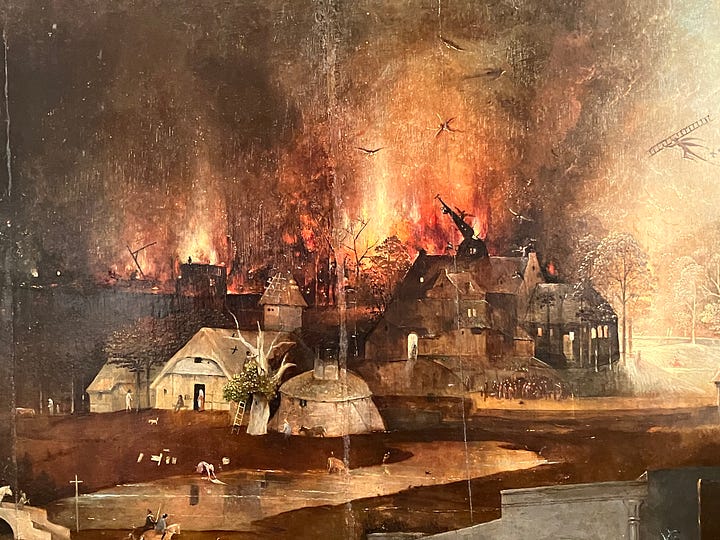
A pig-headed lutenist with a barn owl on his head. A host of sinister creatures emerging from a hollow fruit, the foremost of which is a cow’s skull cloaked in green, playing a harp and riding a leathery beast in clogs. A goldfinch skulking below. An armed and armored fish doubling as a fishing boat manned by monkeys. A bespectacled animal-priest reading from a blue hymnal. A city engulfed in flames. Is this really a scene of temptation?
Anthony, in the middle of the middle panel, pays no mind to the surrounding throng. He looks out, and, pointing with two fingers, leads the viewer’s gaze to Christ, who stands beside an altar in a vaulted niche. Ignore the evils, the distractions, the torments. Focus on this. The title of the work better fits the right panel. Here, Anthony, holding a book, looks away from a nude woman standing in the opening of a hollow tree, looks away from the promise of earthly delight.
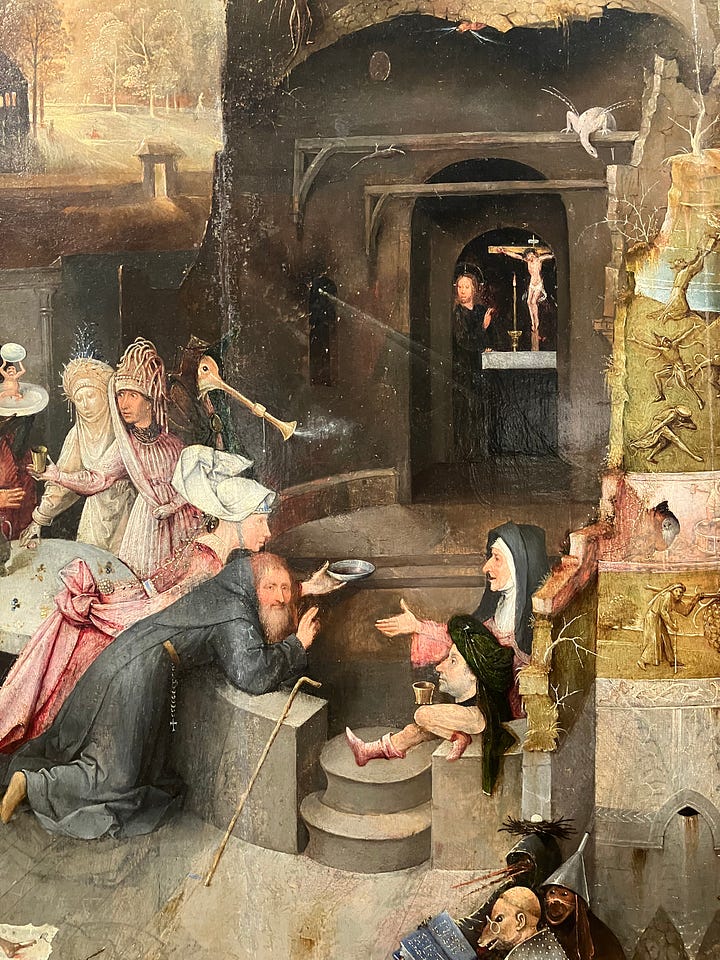
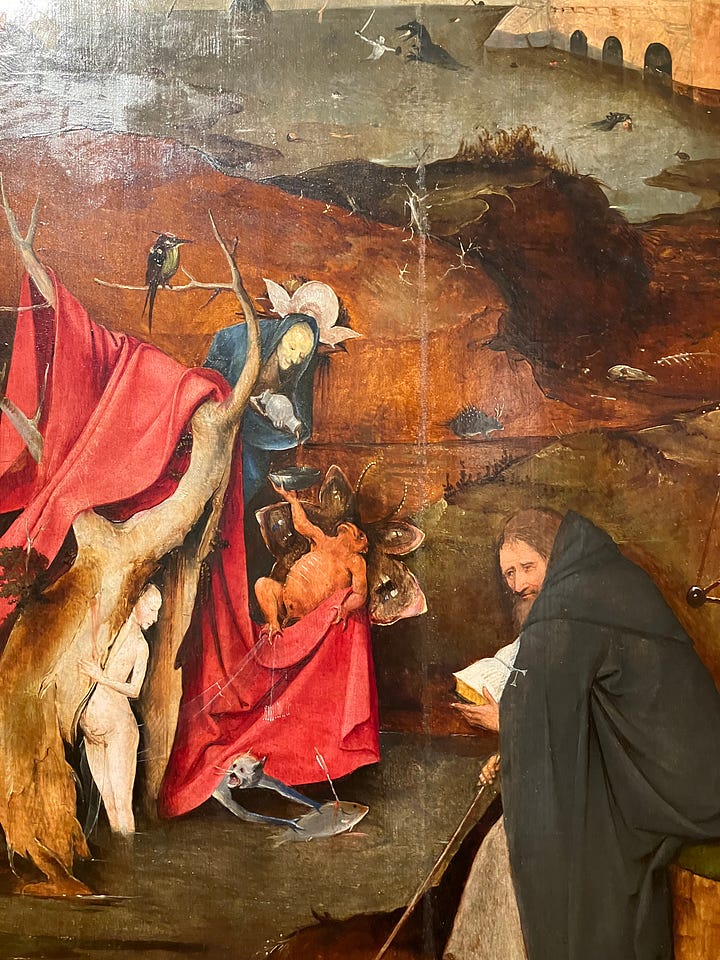
The triptych is just far enough from the wall for one person at a time to inspect the outer panels, where the trials of Anthony are echoed, on one side by the arrest of Christ and on the other by Christ carrying the cross. Bosch may be best-known and loved for the fertility of his imagination, but with his mob accompanying Christ to Calvary he reveals himself also to be a rival of his successor Bruegel when it comes to painting ordinary folk. Who is this round-faced man, standing slightly apart from the crowd, leading a child and balancing a baby on his head? Is the baby feeding an apple to the adjacent soldier? I’m not sure, but everyone here seems to have stepped out of an early, pre-technicolor version of the Peasant Wedding.
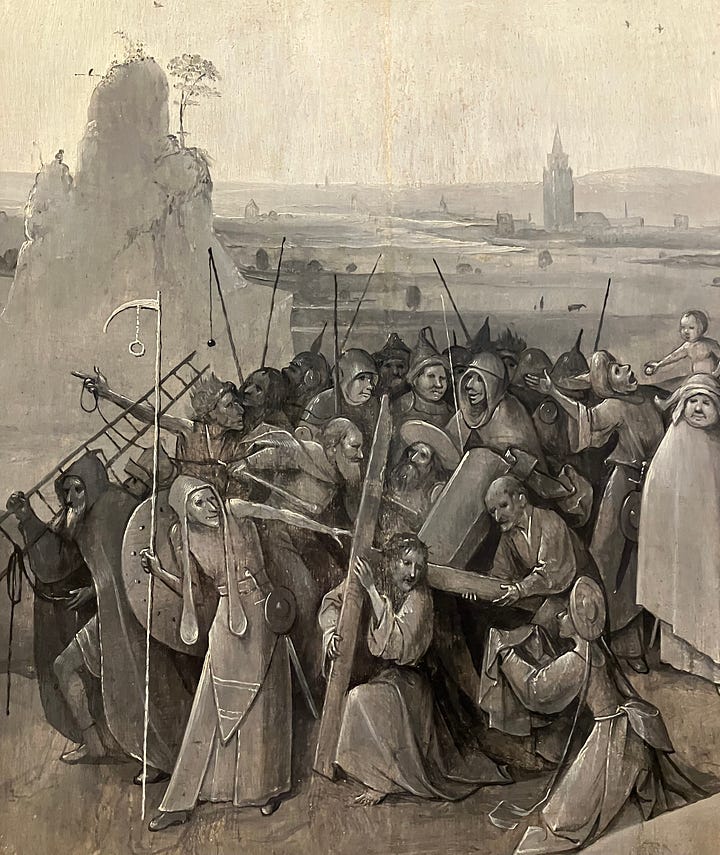
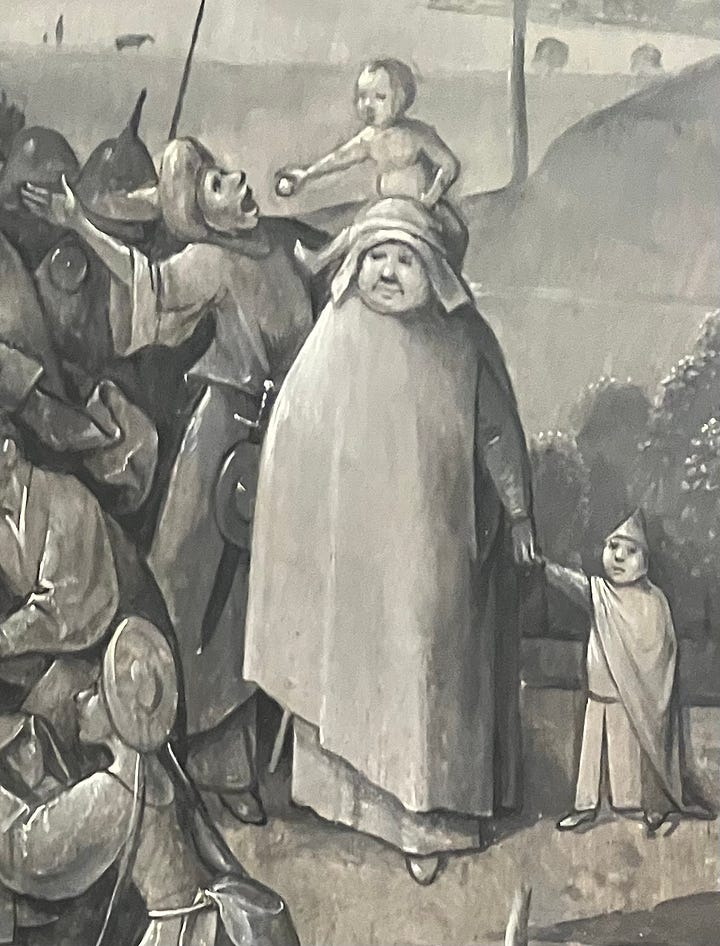
It would be reasonable, I think, to ask, now that you’ve reached the end of this cursory look at a Bosch painting, what’s the goal here? Does one use Bosch as a vehicle in which to travel to Athanasius of Alexandria and late Medieval ergotism? Is he a means to the end of learning about other matters? Or is this cultural context of interest less for its own sake, than because there was once a person named Bosch whose imagination still takes our breath away, and because in a breathless state some of us might wonder things like: What sort of world did this Bosch live in? What exactly has he done in these works? And how did he do it? Progressively more abstract questions. Good luck with the third one.7
*
As for the rest of the European galleries, I will pass over the Piero della Francesca, the Dürer, the Holbein, the room of apostles by Zurbáran, but I want to spend a moment with a painting by a lesser-known artist, Alessandro Allori (1535–1607). I don’t know the Italian art of the second half of the sixteenth century well enough to place him exactly, but I think it’s fairly accurate to say he’s a good but not great Florentine painter from a period when Florentine art had ceased to matter as it once did. An artist known only to specialists. I wouldn’t have given his 1602 Rest on the Flight into Egypt more than a glance and half a thought if I hadn’t chanced to notice the bird in Joseph’s hand. It’s a male cardinal.
From the age of eight or nine I was a child birdwatcher, always pestering my parents to take me on some trip that would enable me to augment my life list. Then, when I grew up a little, this interest began to seem childish and uncool, and I put away my binoculars and Peterson guides and forgot about birds for more than a decade. I rediscovered them in the winter of 2002–03. At the time I was living on one floor of a detached house in the suburbs of Krakow. The owners, who lived upstairs, put out a feeder, and looking out the window that winter I learned the finches, the tits, and the thrushes of Europe. Ever since I’ve been an amateur, no binoculars, no list, but I still have the Peterson guides at home. And I look for birds in paintings. The lapwing in Domenichino’s Archery Contest of Diana and her Nymphs; Holbein’s starling; the canonical magpies (Limbourg Brothers, Bruegel, Monet); the goldfinch, the robin, the green woodpecker, the hoopoe, the kingfisher, the mallard, and the little owl in the Garden of Earthly Delights; the roller’s wing by Dürer; Vittore Carpaccio’s cormorants, hunted in the Venetian lagoon; the heron in Giovanni Bellini’s St. Francis in Ecstasy; Carlo Crivelli’s peacock in his Annunciation with Saint Emidius.
But these are all natives or, in the case of the peacock, domesticated—the birds you’d expect to see in European paintings. The only American ones I’d ever noticed were turkeys and macaws. Both were well-known in Europe in the sixteenth and seventeenth centuries. The odd-looking turkey was an exotic at first, a born candidate for a royal aviary. It makes its debut in European painting in the early 1520’s (just two decades after Columbus saw them on his fourth voyage to the Americas in 1502) in a fresco by Giovanni di Udine in the Villa Madama outside Rome. Before too long the turkey was a delicacy as well, the sort of thing that could serve as a gourmand’s dream in a Dutch still life. The macaw appears in European art even earlier than the turkey, in the 1502 Cantino Planisphere, a Portuguese nautical map, the first one to show parts of South America, Africa and India in their correct latitudinal positions. Its Brazilian interior is inhabited by three scarlet macaws. Later, inevitably, macaws too made their way into the Dutch still life, not because anyone ate them but for their brilliant colors.
The range of the northern cardinal today extends as far south as Mexico, Guatemala and Belize; according to a displeased birdwatchers’ report from 2014, the people of Cozumel keep them as pets (probably the birds are captured and sold by pajareros). So a European who came the Viceroyalty of New Spain could have encountered them, perhaps caged as well as in the wild. Songbirds are short-lived, though, so it’s hard to imagine a cardinal surviving the trip back across the Atlantic. However, if one did, the natural place for it to end up would have been the famous Medici aviary at Pratolino, which was completed in the 1580’s. The English traveler Fynes Moryson, who was there in 1594, found “a large cage of birds, made of wier, and open to the aire, in which are birds of all kindes and [from] many Countries, not only singing to delight the eare, but most pleasant and diverse colours to delight the eye."8
Colorful, exotic, and a good singer—a male cardinal might have been worth his weight in gold to the Grand Duke of Tuscany. As Pratolino is less than ten miles from Florence, the painting by Alessandro Allori is circumstantial evidence in favor of the presence of a living cardinal in the aviary. Either that, or there was a dead one in a Tuscan cabinet of curiosity (there were competent taxidermists in Early Modern Europe). Would a second cardinal amount to corroboration? There is, it turns out, a second cardinal, a commesso (hardstone mosaic) of one in the Galeria Borghese. While its history and origin are unknown, it is likely of Florentine origin and more or less contemporary with the Allori painting. It’s a bit stiffer and less suggestive of a living model, but that may only be a function of the more rigid medium.
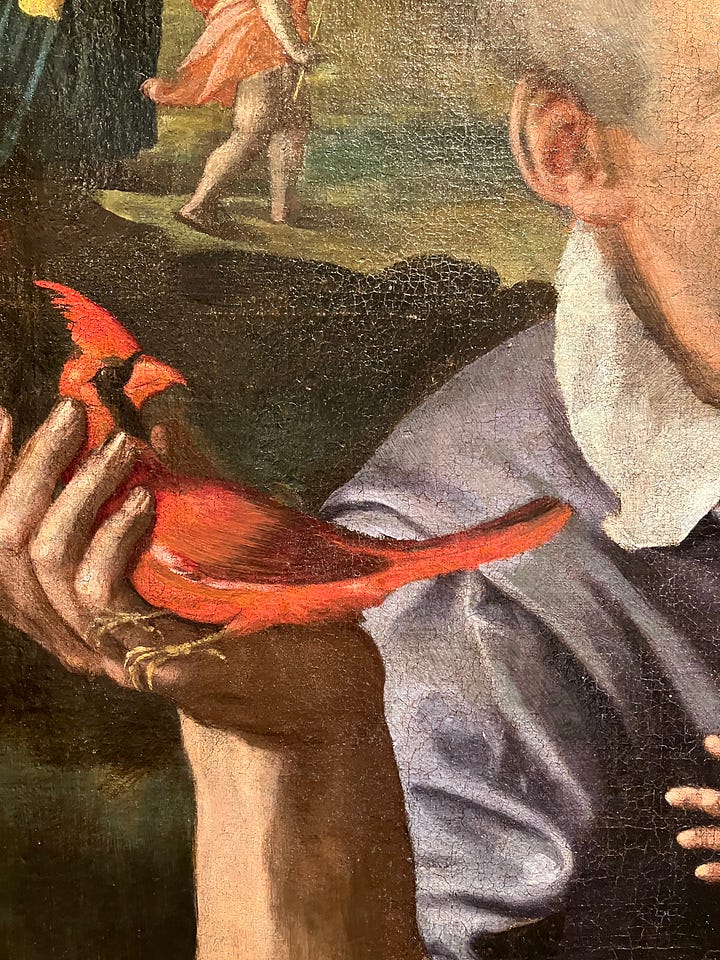

*
When I arrived in Lisbon in January I was coming from Paris, where the temperature was a little above freezing. As I mentioned above, I was only there for two days, on my way home to New York, where the temperature would be a little below freezing. So winter to winter, but with a break—in Lisbon it was in the low sixties. Not sunny, but warm, misty and damp. Outside I wore a light jacket, unzipped, and felt free. Inside, in the museum, in the last room of the European galleries, I came across this painting by Gustave Courbet, and smiled, almost in disbelief. A snow-covered landscape in rural France. What a thing to think about, standing there in that room, at that moment.
To be continued with a second post on Portuguese art at the MNAA.
The Patiño Palace was on sale a few yeas ago, for twenty-three million euros. I can’t find an active listing but there are plenty of pictures here.
I’ve used William Granger Ryan’s translation of the Golden Legend, vol. 1, Princeton University Press, 1993, pp. 93–96.
William, S.J. Harmless, Desert Christians: An Introduction to the Literature of Early Monasticism, Oxford University Press, 2004, p. 60.
From St. Athanasius, the Life of Saint Antony, translated by Robert T. Meyer, Newman Press, 1950, pp. 27–28.
More Sigüenza:
He made variations on this theme so many times and with such invention that it arouses admiration in me that he could find so much to deal with, and it makes me stop to consider my own misery and weakness and how far I am from that perfection when I become upset and lose my composure because of unimportant trifles, as when I lose my solitude, my silence, my shelter, and even my patience.
From the History of the Order of St. Jerome by Fra José de Sigüenza, translated by James Snyder and excerpted in Bosch in Perspective, Prentice Hall, 1973, p. 37.
Like The Truman Show, Bosch’s paintings show everyday life to be a deception, with the deceived being constantly and cruelly observed from afar. The chief difference between the modern and the medieval fables lies in what is imagined to be the cure. In the modern one, escape comes through curiosity, through Truman’s wanting more world rather than less. In the archetypal guise of a seafarer, the hero reaches his exploratory finger to the world’s false outer edge. In Bosch, by contrast, curiosity is a type of pride and thus remains the very sin of sins. Escape from the trap comes therefore not by setting forth to explore the world but by abandoning the world.
Joesph Koerner, Bosch and Bruegel: From Enemy Painting to Everyday Life, Princeton University Press, 2016, p. 155.
Sigüenza proposes a starting point (Bosch in Perspective, p. 36):
[Bosch] knew that he had a great talent for painting and that in many subjects he did he had already been overtaken by Albrecht Dürer, Michelangelo, Raphael of Urbino, and others. Thus he embarked upon a new road, one on which he would leave the others behind while he was not behind anyone else and on which he would turn the eyes of all towards himself: a kind of painting comical and macaronic (on the outside) yet mixing with such jests many things that are beautiful and extraordinary with regard to imagination as well as execution in painting…
Fynes Moryson, An Itinerary: Containing his Ten Yeeres Travell through the Twelve Dominions of Germany, Bohmerland, Sweitzerland, Netherland, Denmarke, Poland, Italy, Turkey, France, England, Scotland & Ireland, quoted in Angela Groom, Exotic Animals in the Art and Culture of the Medici Court in Florence, Brill, 2018, p. 90.




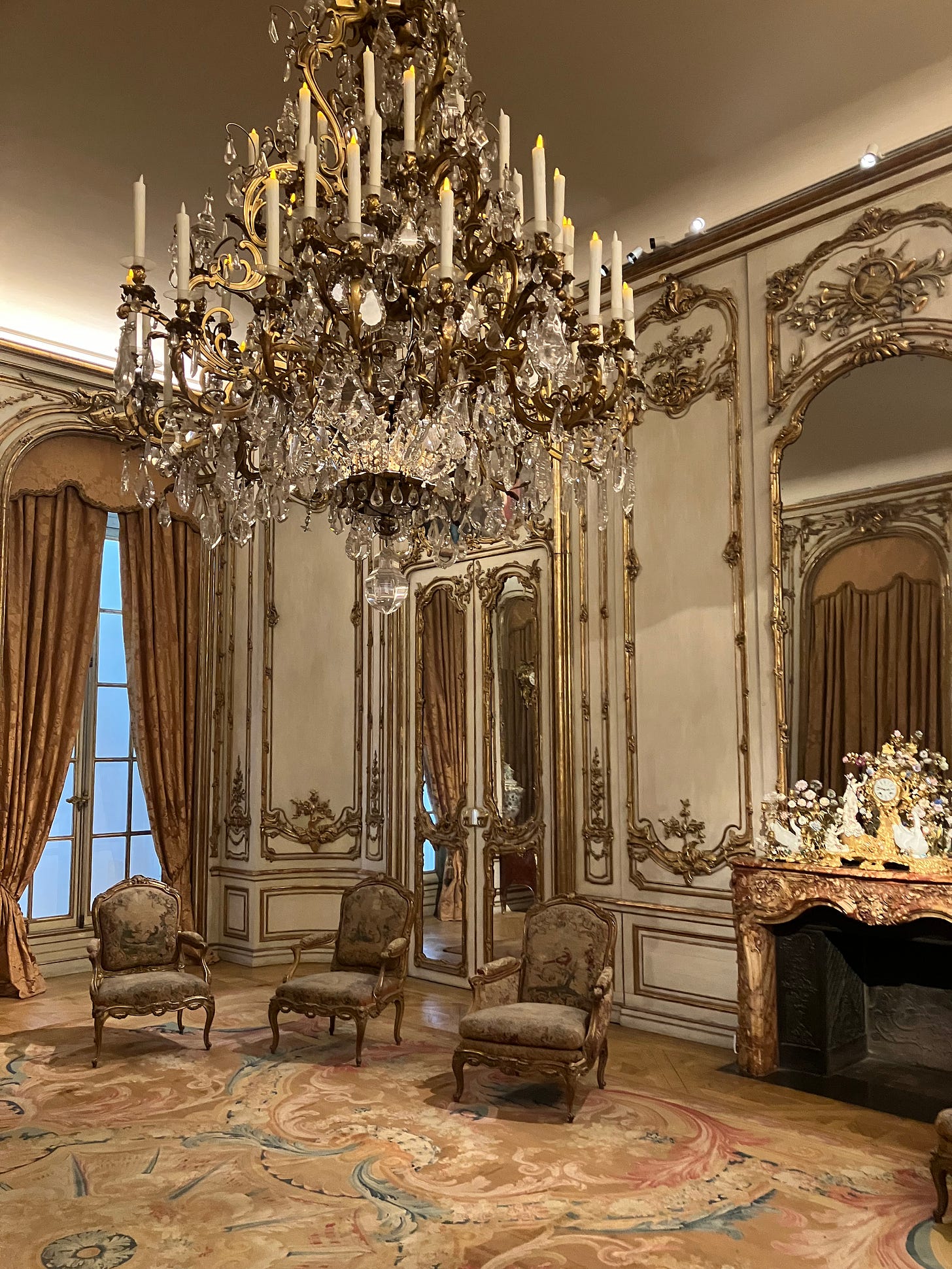
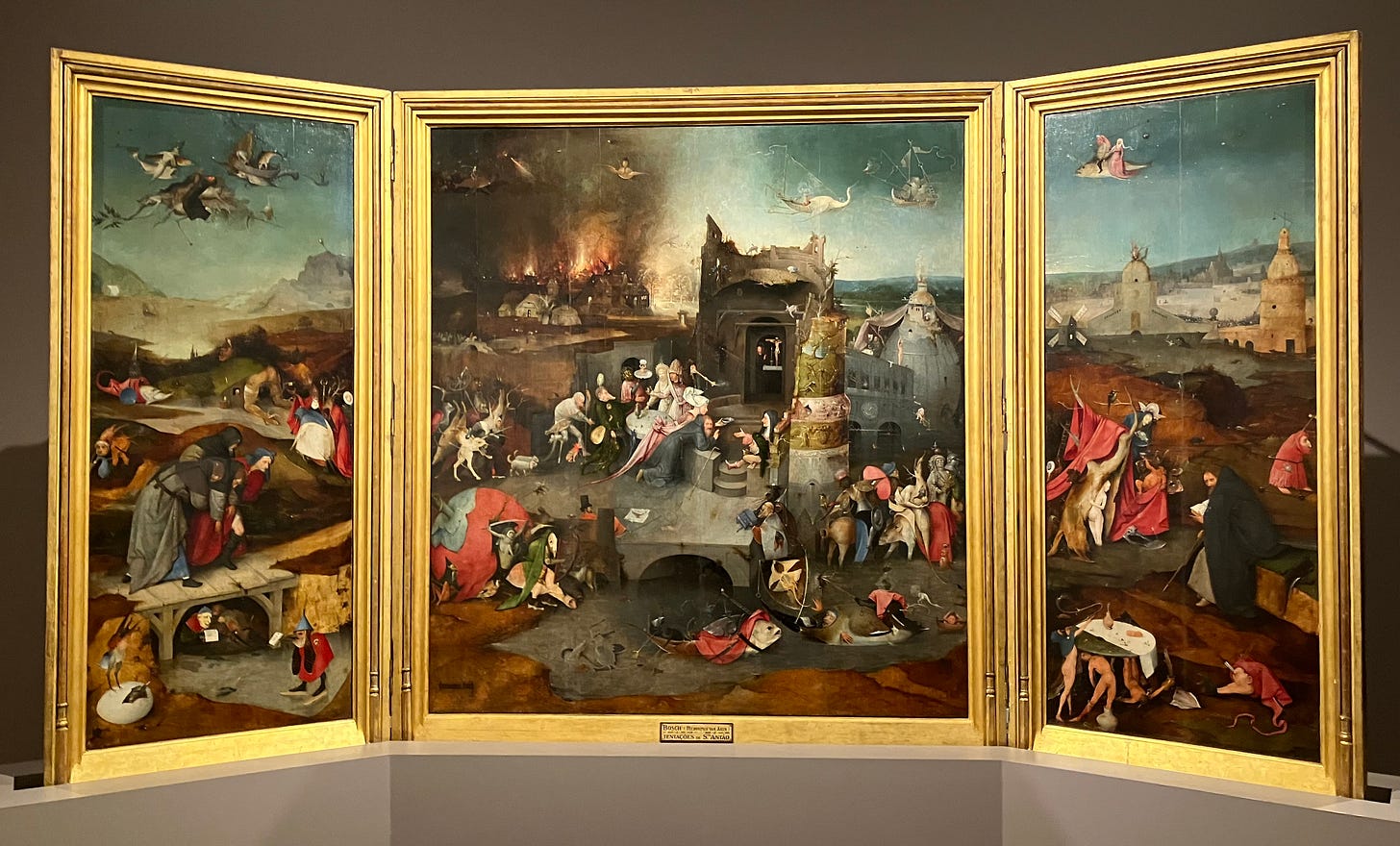
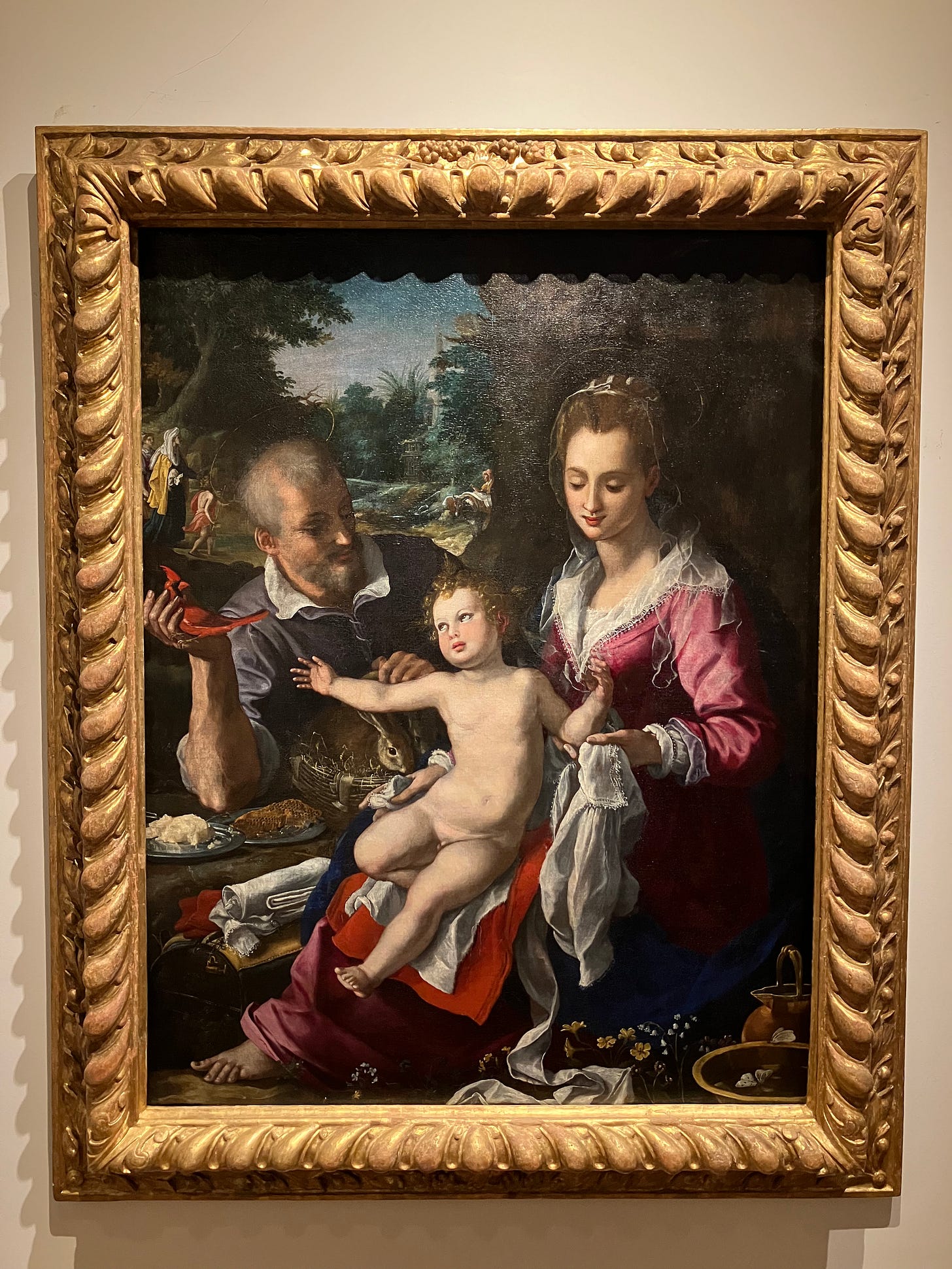
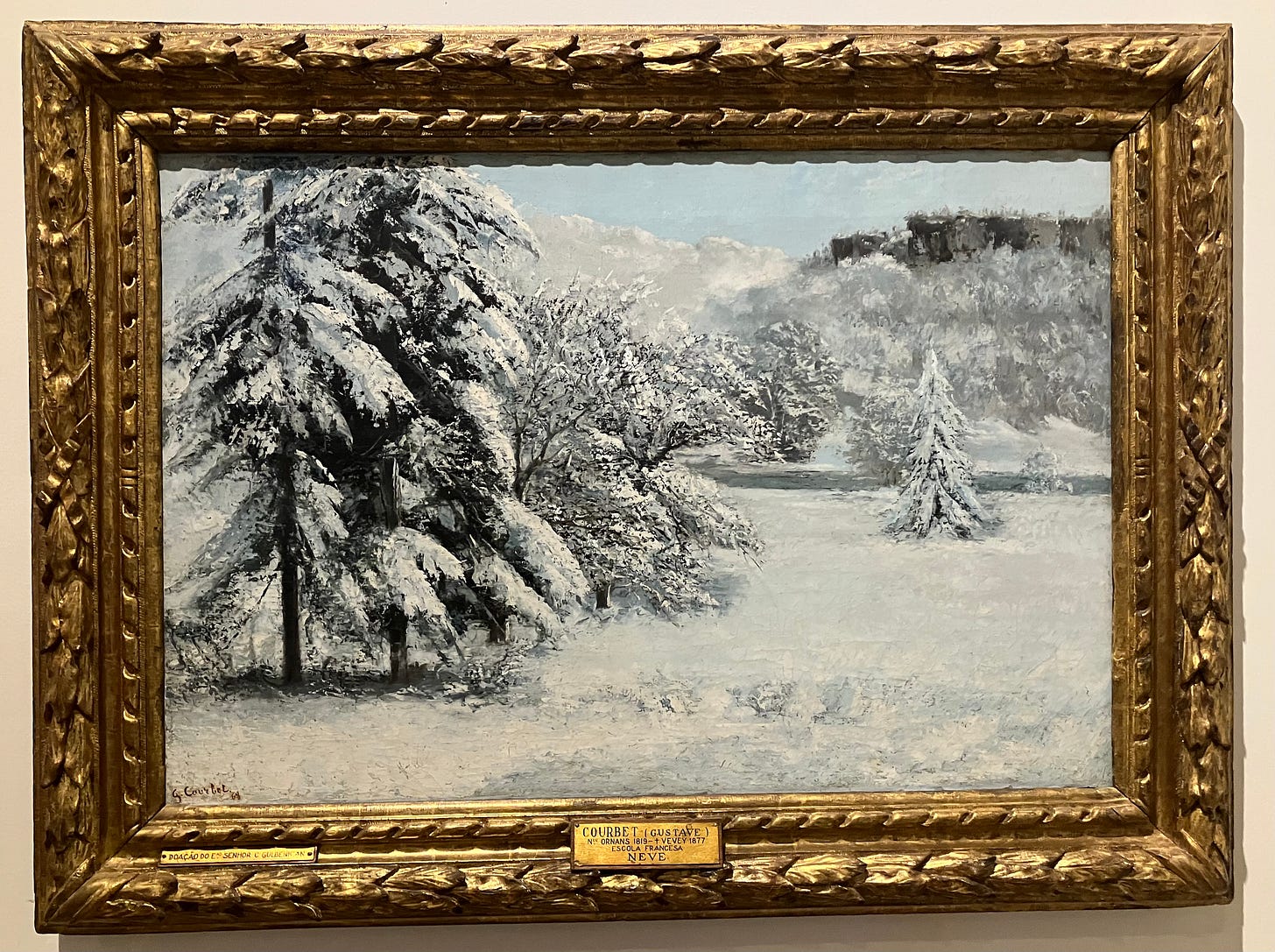
It's so you. I relate totally to the binocs & Peterson guides, all a little dusty but to be dusted off for a trip at the end of June,
I love the research that you do, how you let your curiosity take you to diverse destinations.
I look forward to part II.
Just so you know, the link to the Met didn't work.
Didn't check most of the others. Not enough time.
Keep writing.
As a related, Brown, I knew to expect Thomas to enrich his incisive observations of his visit to the MNAA with historical context, known or researched. I should also not have been surprised to see within the end result what seems to be a singular, inventive analysis of the arrival of New World birds into the artistic works of the Old World.